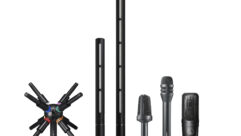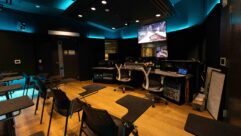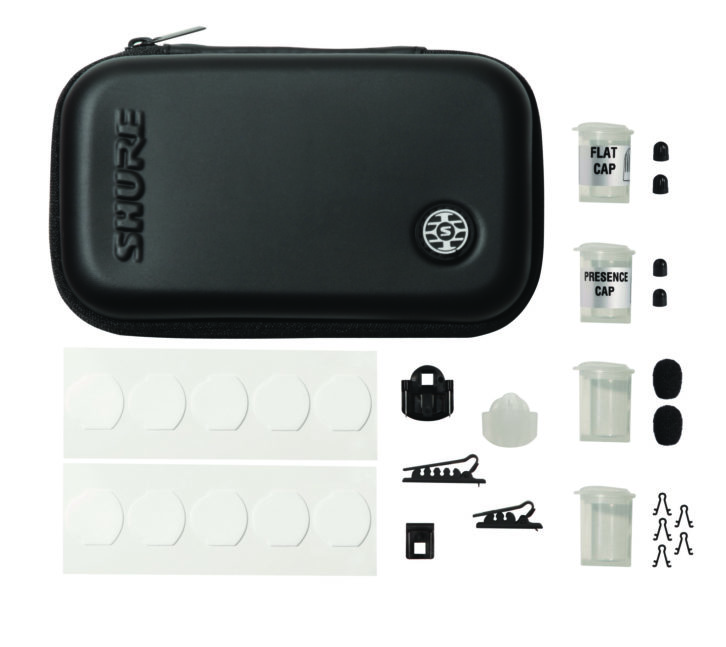
Shure designed the new TwinPlex line of subminiature microphones to address the unique requirements of news reporting, film, television, and, in our industry, corporate events and theatrical productions. These needs include a high level of intelligibility, rejection of unwanted sound, robust construction, compact size and resistance to moisture, as well as a premium user feel.
The TwinPlex line is comprised of four lavalier microphones and one headset microphone; Shure designed them from the ground up over a period of years. The company builds the TwinPlex mics in a dedicated facility using automation as well as hand-crafted construction techniques, with many of the manufacturing steps developed specifically for TwinPlex technology. The result is a range of subminiature microphones that maximize capsule surface area while reducing size and providing exceptional audio performance.
TwinPlex mics employ Shure’s (patent-pending) TwinPlex omnidirectional capsule which features dual-diaphragm construction with independent backplates for each diaphragm. The diaphragms are arranged parallel (back-to-back) in a side-address configuration as opposed to the more typical single-diaphragm, end-address configuration. This approach essentially doubles the diaphragm surface area within the same amount of space, and is intended to yield improved low-frequency response, consistent off-axis response, and lower self-noise. By locating the electronics PCB between the two diaphragms, the overall length of the capsule has been reduced to similar 5mm products.
The TwinPlex line consists of the TL45, TL46, TL47, and TL48 lavaliers (which offer a variety of sensitivity and response curves), and the TH53 headset.
For this review; SVC had the opportunity to use the TL46 lavalier and a TH53 headset. Both mics can be ordered with a choice of connector including LEMO, Microdot, TA4, XLR or no connector; we requested TA4 connectors for use with the Shure Axient Digital wireless system (AD1 bodypack). Each mic is packaged in a semi-hardshell case with a variety of accessories including extra caps used to tailor the frequency response (flat and presence), windscreens, tie, sticky, and vampire clips (-A versions).
The first thing I noticed about the TwinPlex mics was the cable: it’s very pliable and thin (1.6 mm diameter), yet does not feel flimsy. Shure engineers took a great deal of care in developing this medicalgrade cable, employing dual redundant grounds for secondary shielding and cable longevity. The cable is said to have no memory effect, and the paintable jacket resists drying or cracking while remaining extremely flexible. Shure has cable flex machines designed to break cable, and TwinPlex cable reportedly lasts 100 times longer under duress than any cable they’ve ever tested.
The TL46 and TH53 ship with two different removable plastic capsule caps: a flat frequency response cap and a presence peak cap. Initially I couldn’t tell the difference between the caps by looking at them, but closer examination revealed that the vents on the flat cap are longer than those on the presence cap. In addition to their effect on frequency response, the caps serve another important function: they have a hydrophobic coating that repels sweat and moisture, providing longer ‘sweat out’ time (sweat resistance) than an uncoated cap. That might not sound like a big deal but when you consider the fact that theater performers are under hot lights, and that subminiature mics are often concealed in clothing or hair, it becomes apparent why resistance to moisture is critical. Shure actually developed a sweat ‘bot to test and improve capsule performance under simulated sweat drip conditions; that research enabled Shure to extend the sweat out performance of the TwinPlex mics tenfold.
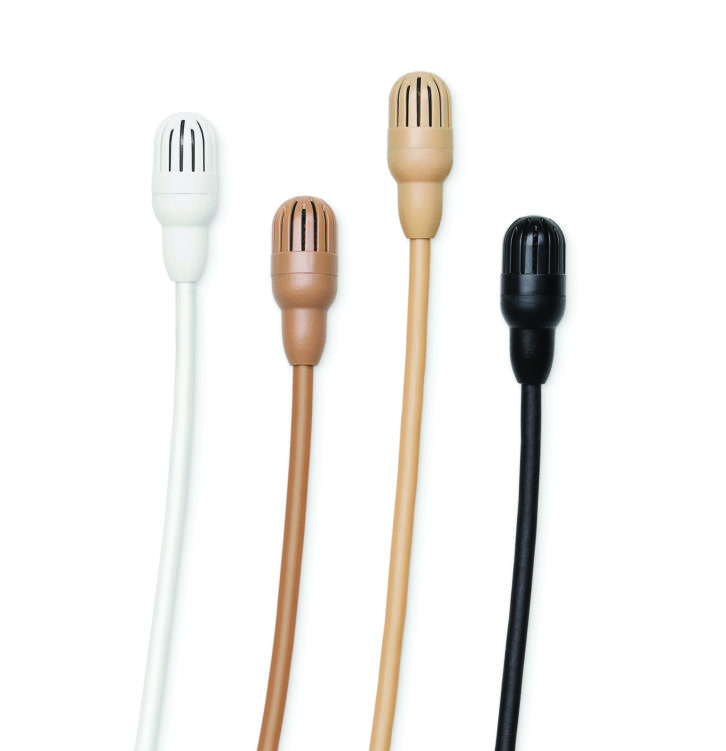 TL46
TL46
The TL46 was designed for high-sensitivity and medium-SPL applications (the TL45 is available for low-sensitivity, highSPL applications). I used the TL46 with the AD1 bodypack in an Axient Digital system for speech reproduction and, after a bit of tweaking of the mic position, the results were excellent. I first used the supplied tie clip to place the mic on the lapel of the speaker’s shirt, a few inches under his chin but this placement yielded a muffled tone, even with the presence cap installed. Moving the mic down a few inches to the button placket made a big difference in clarity, and his voice sounded natural and clear. Rejection of off-axis sound was generally very good, though we experienced a bit of feedback when he turned and faced the speakers (ugh!). I preferred to use the mic without the windscreen because it’s visually less obtrusive that way, but I noticed that if the talent spoke while looking down in the direction of the mic he occasionally produced a plosive sound. The windscreen cured this. The mic is so small that it disappeared on his shirt even with the windscreen installed (it was a black mic on a dark blue shirt). When the talent moved his head — which he did often — there was no detectable change in timbre.
I next used the TL46 to record audio for a video on drum tuning, using both the Axient Digital system and a custom-built preamp that enabled me to connect both TwinPlex mics via wire into an external mic preamp (a Grace 201). Dynamic range of this recording was huge because the audio includes a person speaking in a conversational voice and the sound of a snare drum being whacked, both being captured by a mic that’s about 18 inches away from the drum. The TL46 handled it effortlessly, as did the TH53 headset. Background noise was never an issue and the mics handled the SPL from the drum without distortion.
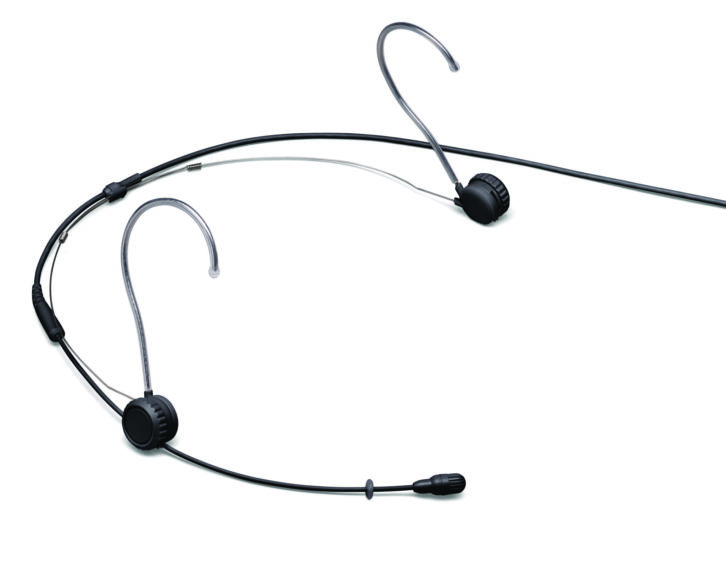 TH53
TH53
I used the TH53 in similar applications, including the drum tuning video. The TH53 seemed to capture a bit less of the room ambience than did the TL46, which enhanced the clarity of the vocal while keeping the snare sound focused. When I first saw the TH53’s headset I thought it looked delicate and had my doubts that it would stay put — but once set in position, it did not move. The TH53 has separate adjustments for headband width, ear hook angle, and boom angle. A pivoting clutch with a thumbwheel sits behind the ear and is used to adjust boom height and boom arm length. Once this is tightened — and it doesn’t take much force — it remains in place. Both sides of the headset have a clutch, so you can mount the boom on either side. Some folks may feel the clutch knobs are a bit on the large side (about a half-inch in diameter) but I did not.
Provided that I placed the headset as suggested in the manual I never heard a plosive sound, nor did I experience any issues with sibilance. The headset really has wonderful fidelity and seemed to deliver a more extended low-frequency response than that of the TL46. Using the presence cap on either model produced a very subtle difference, more adding a sense of air or space as opposed to creating a pronounced peak in the response. I thought I might have heard a bit more emphasis on ‘s’ or ‘t’ sounds with the presence cap but nowhere near the point of sizzle. The caps don’t require a lot of pressure to pull off or push on, yet remain in place securely.
When the TH53 was connected to the AD1 transmitter, I needed to crank the pack’s offset to +18 (pad off) to achieve sufficient audio level as displayed on the front of the Axient AD4D receiver — an increase of more than 12 dB above the setting I used for an instrument cable with the same pack and receiver (the TL46 required a similar increase in offset on the AD1). Regardless, there was no appreciable increase in background noise.
Shure’s efforts in designing the TwinPlex cable have paid off: I never heard any noise generated by clothing rubbing against the cables, or even when handling the cables. The flexibility of the cable along with the supplied accessory clips made easy work of dressing the cable through clothing without it being annoying.
I found that the TH53 and TL46 produced excellent-sounding vocals, though I’d prefer the extended LF response of the TH53 for theater applications where the talent would be singing as well as speaking. As you would hope for a lavalier or head-worn mic, the capsules are small enough to be easily hidden in clothing or hair, yet they produce a full frequency response. Pairing a TwinPlex mic with a Shure Axient Digital ADX Micro Bodypack transmitter should allow concealment of the system under the most challenging of costumes. In quiet applications capsule self-noise was never evident, and both microphones demonstrated the ability to handle wide dynamic range. I gave the TL46 a spray or two with water and it didn’t seem to affect the performance or produce any audible noises.
TwinPlex performance, combined with excellent sound, robust construction and resistance to moisture add up to a line of microphones that will undoubtedly be welcomed into the world of theater, film and TV production.
PRODUCT SUMMARY:
Company: Shure
Pros: great intelligibility, extremely low handling noise, available in a variety of colors including black, cocoa, tan (TL46 also available in white); headset is very stable
Cons: difficult to identify frequency response modification caps (see text)
Price: TL46: $399; TH53: $599 (prices vary depending upon version)
SPECIFICATIONS/TL46
Frequency Response: 20 Hz to 20 kHz
Capsule: dual-diaphragm prepolarized condenser
Pickup Pattern: Omnidirectional
Current Draw: 120 to 240 μA, typical
Bias Voltage: 5 VDC
Sensitivity: -37.0 dBV (14.1 mV) at 1 kHz
Self-Noise: 24.0 dB SPL-A
S/N Ratio: 70.0 dB
Output Clipping Level: 3.0 dBV, 1 kHz at 1% THD, typical
Maximum SPL: 134.0 dB SPL, 1 kHz at 1% THD, typical
Dynamic Range: 110.0 dB typical
Cable Length: 66 inches
Weight Including Cable: 0.42 oz (12 grams)
SPECIFICATIONS/TH53
Frequency Response: 20 Hz to 20 kHz
Capsule: dual-diaphragm prepolarized condenser
Pickup Pattern: Omnidirectional
Current draw: 120 to 240 μA, typical
Bias Voltage: 5 VDC
Sensitivity: -45.0 dBV (5.62 mV) at 1 kHz
Self-Noise: 24.5 dB SPL-A
S/N Ratio: 69.5 dB
Output Clipping Level: 3.0 dBV, 1 kHz at 1% THD, typical
Maximum SPL: 142.0 dB SPL, 1 kHz at 1% THD, typical
Dynamic Range: 117.5 dB typical
Cable Length: 66 inches
Weight Including Cable: 0.63 oz (18 grams)


